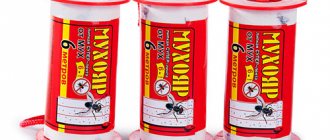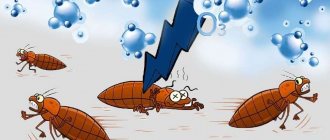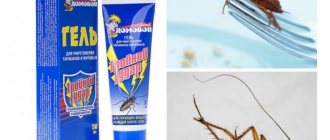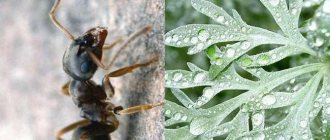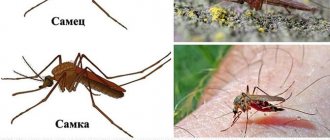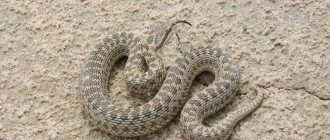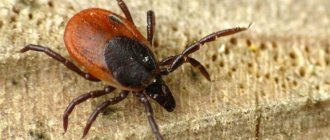Are there mosquitoes in Crimea and how dangerous are they for adults and children?
With the arrival of summer, most of our population begins to suffer from mosquito infestation. The question also arises of where to spend your vacation. Many people choose Crimea. It’s better to find out for yourself whether there are mosquitoes in Crimea before you go on vacation. If you find out that they do exist, you should think in advance about protecting yourself from these parasites. It is worth noting that these insects, which mercilessly suck our blood, live in the Crimea. However, in some regions of the peninsula there are still no pests.
Mosquito boom in Crimea
According to experts, there is nothing unusual about the mosquito invasion in the summer of 2022. A warm spring and plenty of rain in late spring and early summer contributed to the formation of many damp places. Regular rains have restored the normal population of these insects, which had significantly thinned out in previous dry years.
Another reason is the decrease in the number of swallows, swifts and mice. The preparation of Crimean residents in case of another summer without precipitation also made a contribution. Insects did not fail to take advantage of huge barrels of stored water to lay eggs in stagnant water.
Residents of many settlements demand that the authorities chemically treat the places where they breed. It is carried out periodically. Ecologists oppose this, pointing to a possible imbalance in the biosystem. Many birds and fish feed on the larvae of these insects, so massive chemical intervention can deprive them of food.
"Normal occurrence"? Why Crimea became a paradise for mosquitoes
In the Simferopol, Leninsky and Nizhnegorsky regions of Crimea, treatment of areas against mosquitoes has begun. AiF-Crimea found out what the situation is with the population of these insects in the region.
This summer in Crimea turned out to be unusually fruitful for... mosquitoes. Bloodsuckers are attacking cities, villages, and hovering along the coast. A summer generous with rain gave mosquitoes flooded basements in houses, miniature ponds in hollows and huge puddles that did not dry out for a long time. AiF-Crimea found out how they plan to correct the situation on the peninsula.
Where are there no mosquitoes?
The other day, Deputy Prime Minister - Minister of Agriculture of the Republic of Kazakhstan Andrei Ryumshin announced that the treatment of territories against mosquitoes had begun. For now - in Simferopol, Leninsky and Nizhnegorsky districts. In Evpatoria and Feodosia, the mosquito population is being reduced around hotel complexes. In Kerch, anti-mosquito treatment was completed at the end of last week.
In the Dzhankoy district they intend to spend 175 thousand rubles to fight bloodsuckers in 17 villages. And the possibility of using aviation to spray chemicals on areas outside populated areas is being considered.
“In reservoirs where mosquitoes breed, biological insect control agents, such as bactericides and larviol, are actively used,” said Andrey Ryumshin. “The environmentally friendly drug is designed to exterminate the larvae of more than 80 species of mosquitoes.”
Both drugs appear to have a selective effect. Females who are lucky enough to taste blood (without this they cannot reproduce) lay eggs on the surface of the water, and the larvae develop in the reservoir. If “anti-mosquito” drugs get into the water, they inevitably end up in the intestines of the larvae, killing them. Neither other insects nor adult mosquitoes, which are the food of birds, are in danger. Even fish tempted by mosquito larvae will not feel any impact: this was confirmed by research by scientists from the Azov-Black Sea branch of the Federal State Budgetary Institution "VNIRO".
Doctor of Biological Sciences, Professor of the Department of Ecology and Zoology of the Crimean Federal University Sergei Ivanov noted that an increase or decrease in the mosquito population is an absolutely normal phenomenon. If favorable natural conditions exist for a particular species, its numbers are sure to increase. And this year nature favors mosquitoes: the winter was warm, the spring was rainy, and the summer was full of precipitation.
Are there places in Crimea where there are no mosquitoes, or where they are found in small numbers? There is an opinion among people that they do not like junipers and conifers - that is why they are not found there. Indeed, in places such as Kanakskaya Balka in Bolshaya Alushta, the outskirts of Sevastopol, there are indeed very few mosquitoes. But not because the plants are repellent: both junipers and conifers grow in dry places where bloodsuckers simply do not have suitable conditions for reproduction.
From mosquitoes to biting midges
Mosquitoes are found on the southern coast, in the vicinity of Simferopol, in the Belogorsk and Bakhchisarai regions. They go hunting in the evening, and spend the day in a variety of secluded, dark corners.
In the Razdolnensky, Chernomorsky, Leninsky districts you can meet midges, which tourists and locals sometimes call “midges”. Small, penetrating, attack individually and in flocks, biting bloodsuckers can crawl into the ears, nose, and mouth. Midge bites are very painful and often leave behind swollen areas of skin that itch for a long time.
There are four dozen species of real mosquitoes on the peninsula, and eight species “prey” on people.
What can fly on the wings of bloodsuckers? First, people with weakened immune systems may have a severe allergic reaction to the sting. Secondly, bloodsuckers carry pathogens of dangerous diseases.
Mosquitoes, for example, can share the protozoan parasite Leishmania. Once it enters the human body, it causes cutaneous or visceral leishmaniasis. The latter disease can become fatal if left untreated. And in Crimea in the last few years there have been cases of death from leishmaniasis.
Mosquitoes can carry the larvae of the parasitic heartworm. They take root at the site of the bite, grow, and move. In Crimea, ophthalmologists encounter dirofilariasis from time to time, removing worms from the eyes of patients.
In recent years, due to global climate change, some insect species have been “capturing” new territories. This applies, for example, to rapidly spreading mosquitoes that carry various fevers. In Russia, mosquitoes infected with West Nile fever have already been detected on the Black Sea coast.
And in Crimea, the first representative of the “febrile” species - Aedes aegypti, was first discovered in the summer of 2016 in the Saki region and the outskirts of Sevastopol. Since then, “those who came in large numbers” from warmer climes have been seen more and more often on the peninsula. As well as another “invader” carrying malaria. Of course, the likelihood of becoming infected with something dangerous in Crimea after a mosquito bite is extremely low. But it is necessary to remember it.
Where do different species live in Crimea?
Mosquitoes live almost everywhere in Crimea. The appearance of them and their closest “relatives” divided the peninsula into “spheres of influence.” Actually, mosquitoes are especially rampant in the steppe regions of Crimea - Dzhankoy, Bakhchisarai, Simferopol and Razdolnensky.
The southern coast is favored by mosquitoes, whose bites leave painful marks. The midges occupied the coast of the Kerch Peninsula and the resorts of Western Crimea from Sak to the Black Sea. On the popular mountain trails of Crimea, painfully biting hollow bloodsuckers await tourists. On some beaches, vacationers are plagued by horseflies, and in the central regions you can find midges, but not ordinary ones, but blood-sucking ones.
There are no mosquitoes at all in Old Crimea and Evpatoria. There is a constant breeze blowing in these cities. For the same reason, there are few of these insects on the south coast beaches.
Choosing a location: suburb or city?
All private hotels are similar to each other: multi-story construction is not underway yet
Traditionally, there were not many resort areas on the territory of Crimea. Most of them were developed in Soviet times and most often represent arrays of low-rise buildings of the corresponding time.
Workers from nearby industrial enterprises, military personnel and rural residents lived in the suburbs.
Familiar broken streets are slowly being renewed
Recent history has brought tourists to them, and with them low-rise hotels with small cottages. There are a lot of rooms inside, a separate entrance is rare.
Modern hotel complexes are few and far between. But they are present in Yalta, departmental complexes have been preserved in Feodosia, and huge Soviet sanatorium zones have been preserved in Sudak.
Private territory always turns into a garden
The villages on the coast make a rather sad impression: a variety of infill developments, vacant lots, wild beaches with paid sun loungers.
But, unlike cities, in the suburbs there is a clear sea, there are no large ships in the roadstead and no warehouses nearby. And there are fewer people, lower prices.
Malaria and tiger mosquitoes
Mosquito bites can cause worms. As for dangerous diseases, until recently scientists considered the probability of infecting people with them to be negligible. Thus, a malaria mosquito can indeed transmit this disease, but it must first encounter a malaria patient, whom it must bite.
However, recently the situation has changed for the worse: the so-called tiger mosquitoes have reached the peninsula. They are carriers of exotic diseases - Dengue and Zika fevers and chikungunya. They got their name from the black and white stripes on their body and legs. These striped insects are smaller in size than usual. In addition to them, the Asian (Korean) species Aedes koreicus was also discovered in Crimea.
By the way, not everyone knows that mosquitoes, carriers of dangerous diseases, fly up to people silently. The nasty mosquito squeak is produced by relatively harmless insects.
Taxis, public transport and routes
There are no drivers on the gigs.
Transfers - Skodas, around the city - one-year-old Ladas and ten-year-old Japs. Transfer from the airport should definitely not be ordered from a tour operator. The price is almost double the local price: 2 thousand versus 4 thousand.
By public transport, you can get from Beregovoe to Feodosia on an ordinary “groove” for 20 rubles. The same prices apply throughout the city.
I usually took a taxi, ordering in the Maxim app: it cost 250 to Feodosia, 600 to Koktebel, 1000-1500 rubles to Sudak.
A trip to Taigan Safari Park cost 4 thousand + tickets of a thousand each. If you take an excursion and travel by minibus with a group, it will cost 3,500 rubles + tickets.
You can save money if you choose a local service and call by phone: the applications are primitive.
Beregovoe-Feodosia taxi Crimea costs 150, Shark - 180 rubles. Transfer to Simferopol with a child seat costs 2,500 rubles.
There are many disadvantages to this method of movement:
- the cars are mostly new Russian or old Japanese,
- child seats are available for transfer only,
- It is rare to find air conditioning and at least a C-class.
However, there are more advantages:
- drivers willingly talk about life and sights;
- often taken along a beautiful but long route;
- no cash required for travel;
- people are very friendly;
- planted where it will be convenient and interesting.
No seat belt required.
There are no child seats in the cars . In general, taxi drivers are not spoiled and take orders instantly. The wait is long: drivers take orders maybe 5-15 kilometers away.
It is best to travel around Crimea with your own or a rented car: there are many services, it’s easy to find something suitable.
You will have to take it in Simferopol or a large city, but this is the only way to get to the most beautiful places.
The appearance of mosquitoes by time of year
The first mosquitoes in Crimea, as elsewhere, appear at temperatures of +10…+12 °C. The mosquito wave becomes widespread in May. As temperatures rise, their numbers increase, reaching a peak in June at 23 °C. In July and August, insects become fewer: at temperatures of 28 °C and above, mosquitoes can only be seen near wetlands with high humidity. There are even fewer of them in September. Mosquitoes disappear at temperatures of 10 °C and below: they hide near swamps, in hollows and under the bark of trees, as well as in crevices of wooden buildings. Larvae in the form of pupae overwinter in water.
What I managed to see
It was +16 at sea. But beautiful
The journey lasted from May 31 to June 7. We were frankly unlucky with the weather: in Beregovoe it rained every day after lunch, which drove us out to sunny Koktebel and Feodosia.
The first couple of days the temperature remained at +17, but a sweatshirt was only required in the evening, since the climate was milder than the Russian average.
Therefore, we were able to breathe, but not to swim. In addition, a number of interesting events have been cancelled.
It's not the season yet, not everything is built up yet
Since many water parks, dolphinariums and playgrounds are located outdoors, visiting them also had to be abandoned.
On the last day, during the trip to Taigan, there was a heavy downpour on the highway, so all the impressions along the road were behind the glass of the car.
Nevertheless, taking into account the stay-at-home child in our arms, we saw quite a lot.
Embankment of Feodosia. A great place for a walk, but all the small crocodilariums and other children's places are not worth spending money at all.
Museums of Green, Aivazovsky, fish, historical. It's not everyone's taste, but we liked it. And my three-year-old son found something to do inside.
Old town of Feodosia. We walked around the historical areas, there are excellent parks suitable for daily visits.
Tower of Constantine and the Genoese fortress. Once upon a time these were the central places of the Greek Crimea - a slave market and a support base. It is simply impossible to pass by the most ancient places in Russia, but it is interesting only to fans.
Mufti-Jami Mosque. The only surviving historical Muslim religious building in the city and surrounding area.
Dolphinarium “Nemo”. Not bad performances. In addition, there is a dolphin therapy center here. The aquarium of three aquariums makes a sad impression.
Koktebel embankment. Not a bad party place for young people. It's great here without children, but there are a lot of drunk people, which doesn't happen in other cities.
Safari Park Taigan. Europe's largest safari park. A visit is highly recommended: interesting living conditions and a good collection of animals. In addition, there is very beautiful nature around and inside, which offers an excellent view from the Ferris wheel.
Belogorsk. The Greeks called him Mavron Kastron, the Tatars - Karasubazar. A town with an ancient history surrounded by poppy fields.
White rock. Even from a distance she is magnificent. And what views open from it!
For a group with a pensioner and a small child (who slept at lunchtime), the program was very eventful and made it possible to almost completely forget about the bad weather.
How to protect yourself
Protection against all types of blood-sucking insects is the same. Premises in areas where they are active must have mosquito nets. Aerosols containing insecticidal and repellent agents should be applied to clothing. If possible, it should cover open areas of the body. Otherwise, special creams should be applied to them. Natural substances that repel mosquitoes include:
- dried chamomile flowers, stems and leaves;
- elderberry branches;
- juniper, clove, anise, basil, valerian and eucalyptus oils;
- sagebrush;
- pine cone smoke;
- camphor;
- citrus.
Itching at the site of the bite is eliminated:
- cold compress or ice;
- onion juice;
- lemon;
- honey;
- Apple vinegar.
If you have an allergic reaction, you should take antihistamines.

